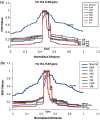Global footprints of purifying selection on Toll-like receptor genes primarily associated with response to bacterial infections in humans
- PMID: 24554585
- PMCID: PMC3971583
- DOI: 10.1093/gbe/evu032
Global footprints of purifying selection on Toll-like receptor genes primarily associated with response to bacterial infections in humans
Abstract
Toll-like receptors (TLRs) are directly involved in host-pathogen interactions. Polymorphisms in these genes are associated with susceptibility to infectious diseases. To understand the influence of environment and pathogen diversity on the evolution of TLR genes, we have undertaken a large-scale population-genetic study. Our study included two hunter-gatherer tribal populations and one urbanized nontribal population from India with distinct ethnicities (n = 266) and 14 populations inhabiting four different continents (n = 1,092). From the data on DNA sequences of cell-surface TLR genes, we observed an excess of rare variants and a large number of low frequency haplotypes in each gene. Nonsynonymous changes were few in every population and the commonly used statistical tests for detecting natural selection provided evidence of purifying selection. The evidence of purifying selection acting on the cell-surface TLRs of the innate immune system is not consistent with Haldane's theory of coevolution of immunity genes, at least of innate immunity genes, with pathogens. Our study provides evidence that genes of the cell-surface TLRs, that is, TLR2 and TLR4, have been so optimized to defend the host against microbial infections that new mutations in these genes are quickly eliminated.
Keywords: Indian populations; Toll-like receptors; evolution; haplotype; innate immune system; purifying selection.
Figures




Similar articles
-
Signatures of natural selection are not uniform across genes of innate immune system, but purifying selection is the dominant signature.Proc Natl Acad Sci U S A. 2009 Apr 28;106(17):7073-8. doi: 10.1073/pnas.0811357106. Epub 2009 Apr 9. Proc Natl Acad Sci U S A. 2009. PMID: 19359493 Free PMC article.
-
Relaxation of selective constraints shapes variation of toll-like receptors in a colonial waterbird, the black-headed gull.Immunogenetics. 2020 May;72(4):251-262. doi: 10.1007/s00251-020-01156-8. Epub 2020 Jan 30. Immunogenetics. 2020. PMID: 31996941 Free PMC article.
-
Episodic positive selection in the evolution of avian toll-like receptor innate immunity genes.PLoS One. 2014 Mar 3;9(3):e89632. doi: 10.1371/journal.pone.0089632. eCollection 2014. PLoS One. 2014. PMID: 24595315 Free PMC article.
-
Porcine Toll-like receptors: the front line of pathogen monitoring and possible implications for disease resistance.Dev Comp Immunol. 2009 Mar;33(3):353-61. doi: 10.1016/j.dci.2008.06.001. Epub 2008 Jun 30. Dev Comp Immunol. 2009. PMID: 18590761 Review.
-
Functional polymorphisms in Toll-like receptor genes for innate immunity in farm animals.Vet Immunol Immunopathol. 2014 Jan 15;157(1-2):1-11. doi: 10.1016/j.vetimm.2013.10.016. Epub 2013 Nov 1. Vet Immunol Immunopathol. 2014. PMID: 24268689 Review.
Cited by
-
Unusual interplay of contrasting selective pressures on β-defensin genes implicated in male fertility of the Buffalo (Bubalus bubalis).BMC Evol Biol. 2019 Nov 26;19(1):214. doi: 10.1186/s12862-019-1535-8. BMC Evol Biol. 2019. PMID: 31771505 Free PMC article.
-
Hybridization with mountain hares increases the functional allelic repertoire in brown hares.Sci Rep. 2021 Aug 4;11(1):15771. doi: 10.1038/s41598-021-95357-0. Sci Rep. 2021. PMID: 34349207 Free PMC article.
-
Purifying selection shaping the evolution of the Toll-like receptor 2 TIR domain in brown hares (Lepus europaeus) from Europe and the Middle East.Mol Biol Rep. 2020 Apr;47(4):2975-2984. doi: 10.1007/s11033-020-05382-x. Epub 2020 Mar 31. Mol Biol Rep. 2020. PMID: 32236892
-
Comparative Genomics of the Waterfowl Innate Immune System.Mol Biol Evol. 2022 Aug 3;39(8):msac160. doi: 10.1093/molbev/msac160. Mol Biol Evol. 2022. PMID: 35880574 Free PMC article.
-
Evolution of toll-like receptors in the context of terrestrial ungulates and cetaceans diversification.BMC Evol Biol. 2017 Feb 16;17(1):54. doi: 10.1186/s12862-017-0901-7. BMC Evol Biol. 2017. PMID: 28209121 Free PMC article.
References
Publication types
MeSH terms
Substances
LinkOut - more resources
Full Text Sources
Other Literature Sources
Medical

